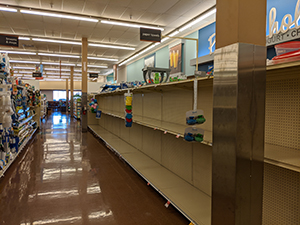
A
weekly e-journal by Art Epstein, OD, FAAO
Off the Cuff: This Too Shall Pass
I promise this will be the last time I write about the COVID-19 outbreak unless I have a pressing need to share new and important information. The last thing any of us need is more perspective and opinion, especially in the absence of solid information and direction. Many of you have reached out to ask what we’re doing in our office during this unprecedented crisis. Since I described new office procedures last week, we’ve made some additional changes. We’re recommending that patients consider delaying routine care, especially older patients with health conditions that place them at greater risk. We’re also staggering appointments to ensure that patients have limited contact with each other and will likely reduce office hours as things continue to evolve. We will continue to provide emergency care and procedures as necessary. Understand that right now, things may be easier for us as the Phoenix metro area has been largely spared. I can only imagine what it’s like in the harder hit areas like San Francisco and New York City. This past Sunday, Shannon and I made a quick run to the supermarket for a few essentials. The picture below is probably familiar to many of you, especially if you needed toilet paper, facial tissue, bottled water and many of the other things that people are panic-buying and hoarding for no sane reason. As I stood there taking the shot, an elderly gentleman stopped and asked if I thought the photo is something I’d show my grandchildren 10 years from now? We chatted briefly, and he shared that he was a World War II veteran and he had never seen anything like this in his life. He said he never imagined that Americans could be so selfish and self-centered and how sad he was seeing something like this at a time we most need to take care of each other and work together to get past this. His words hit hard. My father was a WWII veteran, and I’ve always had a fascination and emotional connection to the greatest generation and how they rose to defend our country, many making the ultimate sacrifice for our freedoms and values. I don’t think I’ve missed a single WWII movie since I was a kid and have always been moved by the depth of American resolve and willingness to sacrifice to put our country and others above ourselves. Sadly, what we’re seeing today in communities throughout the country is not something new that just happened now. It is the result of many years of damage to the very fabric that has for generations made this country so great. I’ve read that some think that things will never be the same after this outbreak. I hope that’s true and that somehow this terrible thing helps us rediscover our sense of community, decency and caring for each other. I pray that we get through this soon and that we are able to look back at this as the time when we rediscovered who we are as a people and what we must be as a country. GBA
|
||||||
| Can the Coronavirus Disease 2019 (COVID-19) Affect the Eyes? | ||||
In December 2019, a novel coronavirus (CoV) epidemic, caused by the severe acute respiratory syndrome coronavirus - 2 (SARS-CoV-2) emerged from China. This virus causes the coronavirus disease 2019 (COVID-19). Since then, there have been anecdotal reports of ocular infection. The ocular implications of human CoV infections have not been widely studied. However, CoVs have been known to cause various ocular infections in animals. Clinical entities such as conjunctivitis, anterior uveitis, retinitis and optic neuritis have been documented in feline and murine models. In this article, the current evidence suggesting possible human CoV infection of ocular tissue is reviewed. The review article will also highlight animal CoVs and their associated ocular infections. Authors wrote that they hoped that the article would serve as a start for further research into the ocular implications of human CoV infections. |
||||
SOURCE: Seah I, Agrawal R. Can the coronavirus disease 2019 (COVID-19) affect the eyes? a review of coronaviruses and ocular implications in humans and animals. Ocul Immunol Inflamm. 2020 Mar 16:1-5. [Epub ahead of print] |
||||
 |
||
| Stepping Up Infection Control Measures in Ophthalmology During the Novel Coronavirus Outbreak: An Experience From Hong Kong | ||||
Coronavirus disease (COVID-19) has rapidly emerged as a global health threat. The purpose of this article was to share local experience of stepping up infection control measures in ophthalmology to minimize COVID-19 infection of both healthcare workers and patients. Infection control measures implemented in the authors’ ophthalmology clinic were discussed. The measures were based on detailed risk assessment by both local ophthalmologists and infection control experts. A three-level hierarchy of control measures was adopted. First, for administrative control, in order to lower patient attendance, text messages with an inquiry phone number were sent to patients to reschedule appointments or arrange drug refills. In order to minimize cross-infection of COVID-19, a triage system was set up to identify patients with fever, respiratory symptoms, acute conjunctivitis or recent travel to outbreak areas and to encourage these individuals to postpone their appointments for at least 14 days. Micro-aerosol generating procedures, such as non-contact tonometry and operations under general anaesthesia were avoided. Nasal endoscopy was avoided as it may provoke sneezing and cause generation of droplets. All elective clinical services were suspended. Infection control training was provided to all clinical staff. Second, for environmental control, to reduce droplet transmission of COVID-19, installation of protective shields on slit lamps, frequent disinfection of equipment, and provision of eye protection to staff were implemented. All staff were advised to measure their own body temperatures before work and promptly report any symptoms of upper respiratory tract infection, vomiting or diarrhea. Third, universal masking, hand hygiene and appropriate use of personal protective equipment (PPE) were promoted. The authors hoped their initial experience in stepping up infection control measures for COVID-19 infection in ophthalmology could help ophthalmologists globally prepare for the potential community outbreak or pandemic. In order to minimize transmission of COVID-19, they wrote that ophthalmologists should work closely with local infection control teams to implement infection control measures that are appropriate for their own clinical settings. |
||||
SOURCE: Lai THT, Tang EWH, Chau SKY, et al. Stepping up infection control measures in ophthalmology during the novel coronavirus outbreak: an experience from Hong Kong. Graefes Arch Clin Exp Ophthalmol. 2020; Mar 3. [Epub ahead of print] |
||||
 |
||
| Consensus of Chinese Experts on Protection of Skin and Mucous Membrane Barriers for Healthcare Workers Fighting Against Coronavirus Disease 2019 | ||||
The authors wrote that health professionals preventing and controlling the coronavirus disease 2019 are prone to skin and mucous membrane injury, which may cause acute and chronic dermatitis, secondary infection and aggravation of underlying skin diseases. This was the consensus of Chinese experts on protective measures and advice on hand-cleaning and medical-glove-related hand protection, mask- and goggles-related face protection, UV-related protection, eye protection, nasal and oral mucosa protection, and outer ear and hair protection. The authors wrote that it is necessary to strictly follow standards for wearing protective equipment and specifications for sterilizing and cleaning, as insufficient and excessive protection could have adverse effects on the skin and mucous membrane barrier. At the same time, they added, using moisturizing products is highly recommended to achieve better protection. |
||||
SOURCE: Yan Y, Chen H, Chen L, et al. Consensus of Chinese experts on protection of skin and mucous membrane barrier for healthcare workers fighting against coronavirus disease 2019. Dermatol Ther. 2020; Mar 13:e13310. [Epub ahead of print]. |
||||
| News & Notes | |
| Ophthalmic Companies Make Coronavirus Testing Available Quidel received Emergency Use Authorization from the FDA to market its Lyra SARS-CoV-2 Assay, a real-time RT-PCR test intended for the qualitative detection of nucleic acid from SARS-CoV-2 in nasopharyngeal or oropharyngeal swab specimens from patients suspected of having COVID-19. Testing is limited to laboratories certified under the Clinical Laboratory Improvement Amendments of 1988 to perform high-complexity tests. EUAs allow for the early availability of important diagnostic tools “when there are no adequate, approved and available alternatives.” Read more. In addition, Avellino is adding additional production shifts for its newly developed coronavirus diagnostic, the Avellino SARS-CoV-2/COVID-19 Test. The ultra-rapid genetic test is in increasing demand so the company is temporarily suspending sequencing operations of its AvaGen genetic test that identifies the risk of developing keratoconus and the presence of corneal dystrophies, in order to meet demand. On March 5, Avellino completed the validation process for AvellinoCoV2 according to FDA issued guidance. The test must be ordered by a physician and cannot be made available directly to the public. Read more. |
|
| ImprimisRx Announces Supply Agreement with EyeCare Services Partners ImprimisRx agreed to a product supply agreement with EyeCare Services Partners. ImprimisRx currently provides a limited number of ophthalmic formulations to practices within the ESP group, but the agreement will expand the number of formulations available to new and existing ESP facilities. Read more. |
|
|
Optometric Physician™ (OP) newsletter is owned and published by Dr. Arthur Epstein. It is distributed by the Review Group, a Division of Jobson Medical Information LLC (JMI), 19 Campus Boulevard, Newtown Square, PA 19073. HOW TO ADVERTISE |


